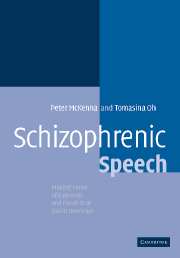Book contents
- Frontmatter
- Contents
- Preface
- 1 Describing schizophrenic speech
- 2 Thought disorder as a syndrome in schizophrenia
- 3 The differential diagnosis of thought disorder
- 4 Thought disorder as a form of dysphasia
- 5 Thought disorder and communicative competence
- 6 Thought disorder as a dysexecutive phenomenon
- 7 The dyssemantic hypothesis of thought disorder
- 8 Some conclusions and a few speculations
- References
- Index
2 - Thought disorder as a syndrome in schizophrenia
Published online by Cambridge University Press: 19 August 2009
- Frontmatter
- Contents
- Preface
- 1 Describing schizophrenic speech
- 2 Thought disorder as a syndrome in schizophrenia
- 3 The differential diagnosis of thought disorder
- 4 Thought disorder as a form of dysphasia
- 5 Thought disorder and communicative competence
- 6 Thought disorder as a dysexecutive phenomenon
- 7 The dyssemantic hypothesis of thought disorder
- 8 Some conclusions and a few speculations
- References
- Index
Summary
If the descriptive psychopathological or phenomenological approach to classification is to be believed, what clinicians lump together as thought disorder is really a disparate group of abnormalities, most of which can make speech difficult to follow on their own, but which are prone to occur in combination. Some of these abnormalities appear to lie in the realm of thought, some in the realm of language, and some in whatever is bracketed by these two concepts. Others may be mirror images of each other or even polar opposites, for example poverty of speech and pressure of speech. Still others just do not seem to be particularly closely related to each other – whatever it is that gives rise to derailment does not seem intuitively likely to be the same as what underlies, say, stilted speech or self-reference.
The set of abnormalities in Andreasen's TLC scale can claim some legitimacy by virtue of being the survivors of a process of natural selection, which saw several alleged phenomena simply die out. It is also true that they can be identified reliably. Even so, the range of abnormalities remains embarrassingly large, and reliability is no guarantee of validity. It may be that a century of deliberation has led to an accurate and complete taxonomy of thought disorder. But it could also be true that the modern classification of thought disorder is nothing more than an example of psychiatry doing what it is regularly accused of doing, namely applying labels to psychological phenomena in an artificial way which obscures their real underlying relationships.
- Type
- Chapter
- Information
- Schizophrenic SpeechMaking Sense of Bathroots and Ponds that Fall in Doorways, pp. 26 - 47Publisher: Cambridge University PressPrint publication year: 2005



